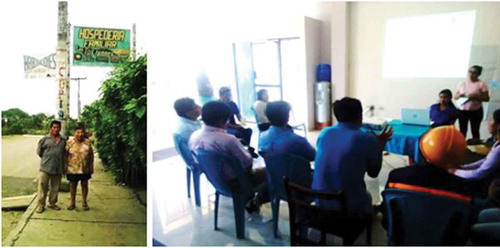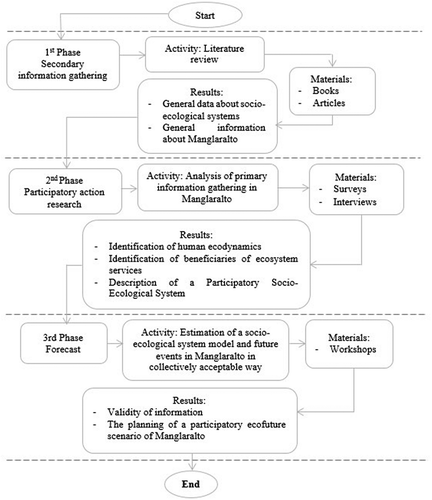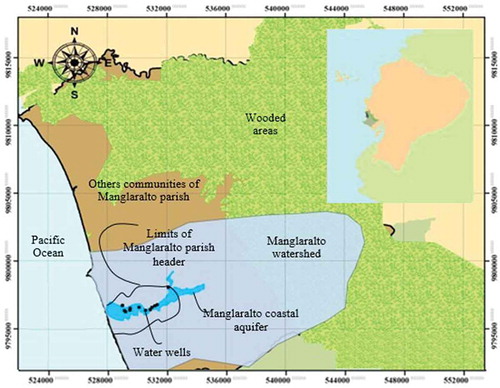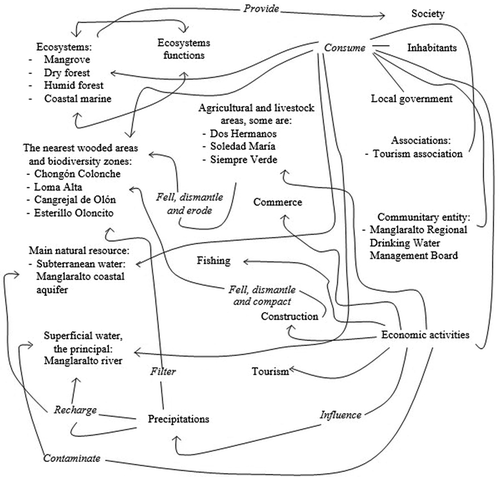ABSTRACT
A socio-ecological system describes dynamics and interactions between society and ecosystems, through social, economic, and ecological processes that influence the state of natural resources. The aim of this paper is to describe the socio-ecological system of Manglaralto through participatory action research in order to understand human ecodynamics and the perception of beneficiaries about ecosystem services focus to the planning of a participatory ecofuture scenario for Manglaralto. The sustainable management of the Manglaralto coastal aquifer has been identified as a key activity. The key stakeholders involved in the socio-ecological system of Manglaralto are the population of rural community, the Manglaralto Regional Drinking Water Management Board, associations, and economic activities, highlighting the tourism. Agriculture ceased to be the most important economic activity in Manglaralto. Its inhabitants have strengthened other economic activities such as small businesses of buying and selling, fishing, and tourism because of its coastal geographical location and the natural and cultural attractions of great tourist potential that it has. A future is glimpsed based on the sustainable use of ecosystem services such as water and tourism.
Introduction
Humans depend on biodiversity and ecosystems (Gosselin & Callois, Citation2018). The environmental changes derived from human activities at local scale, such as vegetation cover transformation, affect the ecosystem functioning; in addition, the social system is affected (Berrouet, Machado, & Villegas-Palacio, Citation2018). Environmental changes affect ecological systems and their ability to provide ecosystem services, so the changes in ecosystem services affect provisions on the welfare of the social system (Fisher et al., Citation2014). A clear focus on environmental sustainability is necessary in order to mitigate the long-term consequences of ecosystems, with attention to interactions with socio-economic and environmental drivers at different temporal and spatial scales (Dick et al., Citation2018).
Human behaviors could change socio-ecological systems through complex human–environmental interactions and long-term histories. So a key challenge for global sustainability is the Anthropocene due to its uncertainty and change that define it. The resilience of natural ecosystems largely depends on internal processes shaped by the long-term interaction, while the resilience of social systems depends on human interventions. The social-ecological resilience is an integrated strategy to improve governance toward sustainability (Chaffin & Scown, Citation2018; Chang, Vadeboncoeur, & Lin, Citation2018).
Humans are part of the environments and ecosystems, and the social and natural subsystems coevolve through mutual interaction and bidirectional influences. Human ecodynamics describe humans and their environments to identify how humans influence on environmental systems and causal relationships between past climate, geography, vulnerability, economy, cultural and social organizations, and other dimensions (Fitzhugh, Butler, Bovy, & Etnier, Citation2018). Socio-ecological researches encompass the study of the human–environment system and society–nature interactions integrating systems in which humans and nature interact (Holzer, Carmon, & Orenstein, Citation2018).
A socio-ecological system is considered as a complex adaptive system with unpredictability, self-organization, multiple stability, the threshold effect, and dependence, where social factors interact with and restrict natural factors (Liu, Willems, Bao, Wang, & Chen, Citation2016). It is an integrated system where societies and ecosystems coevolve and develop, adapting and interacting together. The natural system provides environmental services for the benefit of the social system, whereas the social system develops interventions that directly or indirectly modify the functioning and structure of ecosystems (Rubio Scarano, Citation2017).
A socio-ecological system overlaps the natural and societal spheres; where societal system and natural system are part of a hybrid sphere with various components over space and time, the societal system includes social, economic, cultural, and political characteristics and the natural system includes biological, geological, chemical, and physical characteristics (Liehr, Röhrig, Mehring, & Kluge, Citation2017).
Participatory methods are a dynamic source that generates community processes with a vision of the common benefit, giving possibilities for populations through different entities focus to empower and improve their living conditions. The planning of a participatory scenario for the future of a territory is a projection that allows us to create a shared vision of the future for decision-making in the face of future dangers, promoting dialogues, debates, the cooperation between stakeholders, and the construction of strategies to adapt management to possible future events, in order to achieve sustainable governance where the society reaches a consensus and a common vision of the future on the current situation and future objectives for the sustainability of resources of a territory (Duckett et al., Citation2017; Folhes et al., Citation2015).
The participation of local stakeholders is important to assess ecosystem services and to identify society–ecosystem dynamics and interactions, as evidenced in vineyard ecosystems surrounding the National Park of Doñana in Spain, ecohydrological systemic solutions for water resources management of Manglaralto in Ecuador, the forest cover in arid and semi-arid ecosystems of Beni-Mellal Province in Morocco, and coastal agroecosystem of Puducherry region in India (Barakat, Khellouk, El Jazouli, Touhami, & Nadem, Citation2018; Herrera, Carrión, & Alvarado, Citation2018; Langemeyer, Palomo, Baraibar, & Gómez-Baggethun, Citation2018; Sudhakaran, Ramamoorthy, Savitha, & Balamurugan, Citation2018). The participation of stakeholders in socio-ecological system researches is relevant to understand relationships between societies and environments, through the integration of scientific knowledge and insights of residents about dynamics and interactions of humans and ecosystems in order to the sustainability of resources in a territory (Boyer, Peterson, Arora, & Caldwell, Citation2016).
This paper aims to understand the socio-ecological system of Manglaralto through of a participatory methodology in order to understand human ecodynamics and the perception of beneficiaries about ecosystem services focus to the planning of a participatory ecofuture scenario for Manglaralto. It is divided by four sections: the Introduction section guides the reader about the topic of study; the methodology section describes the materials and methods used in this research; the Results section describes human ecodynamics, the perception of beneficiaries about ecosystem services, the participatory socio-ecological system of Manglaralto, and the planning of a participatory scenario for the future of Manglaralto; and finally the paper ends with Discussion and Conclusion sections.
Materials and methods
This paper uses participatory action research through a methodology based on surveys, interviews, and participatory workshops focused on promoting dialogues, debates, and the cooperation between local stakeholders as shown in .
The methodology is divided into three phases. The first phase is about secondary information gathering through different analysis of documents such as books, development territorial plans, articles, and research papers obtained from specialized databases, in order to obtain general data about socio-ecological systems and general information about Manglaralto parish. This phase was effectuated in a continued way during all the period of this research, from May 2016 to April 2018.
The second phase is the participatory action research; this method allowed the dialogue between stakeholders, such as associations, government organizations, and inhabitants involved in this territorial process. This phase was effectuated during July 2016 to April 2017, where 400 surveys and 6 interviews were developed. Surveys were conducted to local population and tourists in Manglaralto. Surveys were developed using the simple random sampling method. Interviews were conducted to a representative of the local government: Miller Muñoz, representative of local water board, Johnny Limón, and Rocío Muñoz and three other people who are engaged in agriculture and tourism activities.
The third phase is about the forecast of the future of Manglaralto according to solutions for sustainability of natural resources and the planning of a participatory ecofuture scenario for Manglaralto. First, they were elaborated through desktop work by researchers, and then, they were validated and collectively accepted in two workshops. This phase was effectuated from May 2017 to February 2018. 20 individuals participated in each workshop. Profiles and backgrounds of individuals were multidisciplinary. Inhabitants, representatives of water board, representatives of local government, and representatives of associations like livestock and tourists participated. The general scheme of this paper is shown in .
Results
Manglaralto
The Manglaralto rural parish header is located in Santa Elena province of the Republic of Ecuador, in an extension of 60 km2 where 5000 inhabitants live approximately. It has an average temperature between 23°C and 25°C. In 1900, Manglaralto was the main commercial port of Ecuador, exporting products to Europe. It exported toquilla straw, leather, tagua, coffee, and others. However, a fire consumed the rural community and caused the end of commercial activity. The population is mainly in charge of retail trade, agriculture, livestock, forestry, and fishing activities. The activities of buying and selling and tourism generate the main local income in the parish. In recent years, agriculture has ceased to be one of the most important economic activities in Manglaralto because of scarcity of water. So the inhabitants have strengthened other economic activities such as fishing and tourism because of the natural and cultural attractions of great tourist potential that the province has and its coastal geographical location (Arias et al., Citation2015), as shows in .
Manglaralto faces structural problems of Ecuadorian rural areas, such as lack of access to basic services, deficiency, and lack of sewage for the elimination and treatment of solid and liquid wastes. The Manglaralto Regional Drinking Water Management Board (JAAPMAN, for its acronym in Spanish) is in charge of managing the Manglaralto coastal aquifer since 1980 and supplies water through pipes to homes to the Manglaralto rural parish header and others five rural communities: Montañita, Río Chico, Cadeate, San Antonio, and Libertador Bolívar, through 10 water wells. The territory is sufficiently porous to allow infiltration and recharge of the coastal aquifer. However, there is a shortage of rainfall in the sector and insufficient hydrological–climatic information (Herrera, Gavín-Quinchuela, Alvarado-Macancela, & Carrión, Citation2017).
Human ecodynamics
One of the main problems of Manglaralto parish header is the sustainability of water resources. Manglaralto is mainly satisfied with groundwater from the Manglaralto coastal aquifer. However, the Manglaralto river-coastal aquifer system has been affected by the growing water demand, the increase of constructions of urbanized areas for housing and tourist activities on the banks of the river, the advance of the agricultural frontier, and the diminution of humid forest and wooded areas. The overexploitation of the Manglaralto coastal aquifer is remarkable. In 2011, it was considered as an example case by the United Nations for its participative management and to satisfy 100% of the water services to the population, and then in 2015, protests of inhabitants began due to regulatory measures such as schedules of water supply to avoid the depletion of the coastal aquifer.
In addition to the alarming periods of water scarcity in Manglaralto, problems caused by deforestation, soil erosion, low rainfall, and climate change have had important consequences in ecosystems. shows the main changes in Manglaralto in the most relevant aspects such as water, biodiversity, population, tourism, and conservation, and shows the main dynamics and interactions in the territory of Manglaralto parish header.
Table 1. Main changes in Manglaralto parish header.
Perception of beneficiaries about ecosystem services
In the Manglaralto parish header, the main ecosystem service perceived by beneficiaries is the ecosystem service of supply: water, fishing, and agriculture. shows the main ecosystem services, their trend, and the scale at which the service demands.
Table 2. Perception of beneficiaries about ecosystem services of Manglaralto.
Participatory socio-ecological system
This section integrates the human–environment system and society–nature dynamics and interactions through two pillars and interrelated systems: social and ecologic system. This system was elaborated through a participatory process with stakeholders involved. The social aspect includes economic and cultural characteristics, while the ecological aspect includes environmental characteristics, resources, and its sustainable management. shows a participatory model of the socio-ecological system of Manglaralto.
Table 3. Socio-ecological system of Manglaralto.
Participatory ecofuture scenario
Water is the backbone. The priority is to reforest forests and ecological corridors and an adequate administration of resources. The identity of Manglaralto is strongly reinforced. The territory is expected to be managed in a sustainable manner and it is becoming a diverse landscape mosaic in uses, focusing on supporting ecosystems and promoting the high level of associated biodiversity and the economic and cultural activities.
The recovery of natural capital is remarkable and enhances productive uses. Education becomes a driver of change, and the participation of social actors generates social cohesion that improves the quality of management; promoting the development and consolidation of economic activities for small entrepreneurs and artisans under a culture of long-term sustainability, based on an offer of quality goods and services. Therefore, Manglaralto achieves a model of responsible tourism and management based on strengthening the supply of ecosystem services and human well-being.
Discussion
Manglaralto has valuable natural resources within its territory, which generate essential ecosystem services for the population. However, the lack of policies and ordinances, overexploitation, and an inadequate management of resources have triggered the degradation of biodiversity. In a sustainable and integrated management of the natural capital – population, government, and economic and tourist activities – through scientific and technical researches, the development of methods of protection and ecological restoration is intended, reaching a more efficient and an adaptive productive system, such as the work that is being done by university government institutions and associations–community with the purpose of integrating scientific ancestral knowledge.
As a result of an inadequate management, Manglaralto can suffer ecological imbalances and social conflicts, such as lack of water. The excessive use of water, added to the low rainfall, generates scarcity that triggers conflicts. Agriculture decreases and self-sufficiency is affected. Biodiversity is decreasing. Tourism activity may fall; so an increase in unemployment will be inevitable. The cultural and territorial singularity of Manglaralto is lost, to be supplanted by a global identity for market purposes. The territory can become fragile, endangering the natural capital and the survival of species.
Social and ecological problems force an increase in their joint research for management (socio-ecological). Uncertainties arise in the dynamics of resources, considering the low rainfall as a determining factor for the recharge of the coastal aquifer. Effects of climate change in Manglaralto are evident, resulting in temperature increases and decreases in precipitation. Therefore, there is evidence of the need to coordinate actions, the establishment and implementation of public policies that allow the regulation, and use of spaces in order to mitigate negative impacts on ecosystems of Manglaralto.
Aquifers are strategic resources for local development in rural communities, such is the case of Manglaralto parish header. The parish is 157 years old. It is located in the coastal zone. It has a single source of water, which is the coastal aquifer. It is managed by a community entity since 1980. This community management was an initiative of the local population to counteract the lack of water. The community did not receive water by public water companies through pipes; instead, they were supplied water through water delivery trucks. Through the Water Law of 1979 of Ecuador, the community water board was created. It is important to note that in Ecuador all natural resources belong to the State. There are water boards in Ecuador in places where there are no public water companies, and they are formed by residents in a democratic way.
To enhance the dual connection, “water-local development” is relevant to consider the socio-economic system and participatory methodologies that articulate research-participation mechanisms, which are developed and adapted according to the territorial and cultural aspects of the community to establish collectively acceptable solutions for the sustainable management of Manglaralto’s resources. With the participation of stakeholders and their knowledge about Manglaralto’s ecosystems, a shared management model of the socio-ecological system was designed, which reflects on the management and sustainability and promotes the resilience of the territory.
Manglaralto is considered as a geosite within the Ancon-Santa Elena Geopark Project because it has a unique value, by integrating geological, hydrogeological, cultural, and tourist features. The territory has geodiversity and biodiversity, and geoeducation, geoconservation, and the construction of dynamic and adaptive natural systems can deal with disturbances produced by human activities and climate change.
Conclusion
A conceptual model focused on a socio-ecological system through a participatory process was created. It is an analysis tool for the planning and management of sustainability in Manglaralto, becoming a shared model of the socio-ecological system of Manglaralto based on the close relationship between its ecosystems and the human well-being of its inhabitants. Participatory planning aims to raise awareness, warn of possible future dangers, and anticipate possible changes before they occur.
The Manglaralto coastal aquifer is a natural hydrogeological formation. It is nearest to the forested areas such as the Dos Mangas Ecological Reserve and the Chongón-Colonche Mountain Range. The Manglaralto coastal aquifer generates a sense of belonging to the territory, it is the icon of cultural identity, and it fulfills the function of equilibrium in ecosystems, being of vital importance in the development of rural communities, boosting the local economy, and stimulating tourism services. Anthropogenic pressure could cause resource’s depletion and to increase the risk in rural communities of Manglaralto.
In the planning process the exchange of ideas, the empowerment and the joint decision-making were developed. Stakeholders such as representatives of the parish, the water board, inhabitants of rural communities and researchers are working together for sustainable development of Manglaralto parish. Beneficiaries perceived mainly the ecosystem services of supplying, such as water, fishing, agriculture; cultural: tourism (main economic activity); and regulation: air purification.
Ecosystem services from natural capital maintain human well-being in Manglaralto parish header. The main direct drivers of change are water shortages, deforestation, and climate change; factors that visibly affect ecosystems and services provided for the social system. The indirect drivers are the lack of specific policies, the non-application of the law, and the lack of understanding of some authorities and institutions, so it has triggered an inefficient management of the territory and consequently the loss of biodiversity.
In a territory, it is important to identify the variety of natural resources that it possesses, as well as its dynamics and its interactions with the society. The water resource in Manglaralto is a dynamic agent of other resources, and its good management will give opportunities for local development. Manglaralto envisions reaching the sustainable management of the natural system and the social system. This integrating vision of its components is focused on preventing undesired states and counteracting the decrease in the flow of ecosystem services for society.
Disclosure statement
No potential conflict of interest was reported by the authors.
References
- Arias, M., Quijano, D., Rodríguez, M., Obando, V., Robalino, H., Quirumbay, D., … Orrala, W. (2015). Plan de Desarrollo y Ordenamiento Territorial de la parroquia rural Manglaralto 2014–2019. Manglaralto: Secretaría Nacional de Planificación y Desarrollo. Obtenido de http://app.sni.gob.ec/sni-link/sni/PORTAL_SNI/data_sigad_plus/sigadplusdocumentofinal/0968538230001_Actualizaci%C3%B3n%20PDYOT%202014-2019%20Parroquia%20Manglaralto_26-10-2015_06-41-43.pdf
- Barakat, A., Khellouk, R., El Jazouli, A., Touhami, F., & Nadem, S. (2018). Monitoring of forest cover dynamics in eastern area of Béni-Mellal Province using ASTER and Sentinel-2A multispectral data. Geology, Ecology, and Landscapes, 2(3), 203–215.
- Berrouet, L., Machado, J., & Villegas-Palacio, C. (2018). Vulnerability of socio-ecological systems: A conceptual framework. Ecological Indicators, 84(1), 632–647.
- Boyer, R., Peterson, N. D., Arora, P., & Caldwell, K. (2016). Five approaches to social sustainability and an integrated way forward. Sustainability, 8(9), 878.
- Chaffin, B., & Scown, M. (2018). Social-ecological resilience and geomorphic systems. Geomorphology, 305(1), 221–230.
- Chang, C., Vadeboncoeur, M., & Lin, T. (2018). Resistance and resilience of social–ecological systems to recurrent typhoon disturbance on a subtropical island: Taiwan. Ecosphere, 9(1), 1–18.
- Dick, J., Orenstein, D., Holzer, J., Wohner, C., Achard, A., Andrews, C., … Van Ryckegem, G. (2018). What is socio-ecological research delivering? A literature survey across 25 international LTSER platforms. Science of the Total Environment, 622–623(1), 1225–1240.
- Duckett, D. G., McKee, A. J., Sutherland, L. A., Kyle, C., Boden, L. A., Auty, H., … McKendrick, I. J. (2017). Scenario planning as communicative action: Lessons from participatory exercises conducted for the Scottish livestock industry. Technological Forecasting and Social Change, 114(1), 138–151.
- Fisher, J. A., Patenaude, G., Giri, K., Lewis, K., Meir, L., Pinho, P., … Williams, M. (2014). Understanding the relationships between ecosystem services and poverty alleviation: A conceptual framework. Ecosystem Services, 7(1), 34–45.
- Fitzhugh, B., Butler, V., Bovy, K., & Etnier, M. (2018). Human ecodynamics: A perspective for the study of long-term change in socioecological systems. Journal of Archaeological Science: Reports, in Press. doi:10.1016/j.jasrep.2018.03.016
- Folhes, R. T., Dutra deAguiar, A. P., Stoll, E., Dalla-Nora, E. L., Araújo, R., Coelho, A., & Do Canto, O. (2015). Multi-scale participatory scenario methods and territorial planning in the Brazilian Amazon. Futures, 73(1), 86–99.
- Gosselin, F., & Callois, J. (2018). Relationships between human activity and biodiversity in Europe at the national scale: Spatial density of human activity as a core driver of biodiversity erosion. Ecological Indicators, 90(1), 356–365.
- Herrera, G., Carrión, P., & Alvarado, N. 2018. Participatory process for local development: Sustainability of water resources in rural communities. Case Manglaralto-Santa Elena, Ecuador. In W. Leal Filho (ed.), Handbook of sustainability science and research, world sustainability series (págs. 663–676). Cham: Springer. ISBN 978-3-319-63007-6. doi:10.1007/978-3-319-63007-6_41
- Herrera, G., Gavín-Quinchuela, T., Alvarado-Macancela, N., & Carrión, P. (2017). Participative analysis of socio-ecological dynamics and interactions. A case study of the Manglaralto coastal aquifer, Santa Elena-Ecuador. Malasyan Journal of Sustainable Agriculture, 1(1), 19–22.
- Holzer, J., Carmon, N., & Orenstein, D. (2018). A methodology for evaluating transdisciplinary research on coupled socio-ecological systems. Ecological Indicators, 85(1), 808–819.
- Langemeyer, J., Palomo, I., Baraibar, S., & Gómez-Baggethun, E. (2018). Participatory multi-criteria decision aid: Operationalizing an integrated assessment of ecosystem services. Ecosystem Services, 30(Part A), 49–60.
- Liehr, S., Röhrig, J., Mehring, M., & Kluge, T. (2017). How the social-ecological systems concept can guide transdisciplinary research and implementation: Addressing water challenges in central northern Namibia. Sustainability, 9(7), 1109.
- Liu, H., Willems, P., Bao, A., Wang, L., & Chen, X. (2016). Effect of climate change on the vulnerability of a socio-ecological system in an arid area. Global and Planetary Change, 137(1), 1–9.
- Rubio Scarano, F. (2017). Ecosystem-based adaptation to climate change: Concept, scalability and a role for conservation science. Perspectives in Ecology and Conservation, 15(2), 65–73.
- Sudhakaran, M., Ramamoorthy, D., Savitha, V., & Balamurugan, S. (2018). Assessment of trace elements and its influence on physico-chemical and biological properties in coastal agroecosystem soil, Puducherry region. Geology, Ecology, and Landscapes, 2(3), 169–176.




